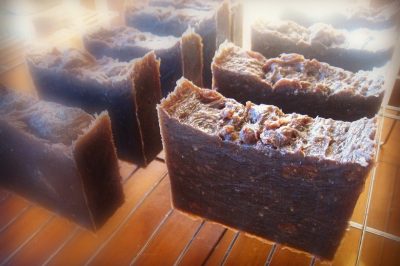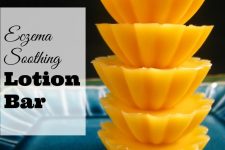I’ve found my “happy hair place.”
A few months ago, I started coloring my hair with henna…
…and so the love affair began!
I use a dark brown henna and there are so many varieties of henna (Lawsonia inermis) to choose from — and the whole experience is nothing short of pure goodness. Combined with my usual natural hair care routine (i.e. shampoo bars + vinegar/herbal conditioning rinse) things are super balanced + peaceful.
Rosemary Gladstar said so perfectly,
“I use henna as a transformational tool, not to cover natural hair color but to enhance it; to change not the way you look but the way you feel about yourself. Though I’ve used henna primarily as an external coloring agent for hair, I’ve long suspected its powerful medicinal properties. I noticed early on that whenever I used henna on people, their energy changed, brightened, they seemed refreshed and renewed. It was different from going to the beauty salon and having their hair colored. People seemed to feel better. It definitely relieved head tension and seemed to help people relax.”
And the more I learned about henna…
…the idea came to me!
A henna shampoo bar…a universal one…something every hair color could use and benefit from!
My research lead me to discover neutral henna (Cassia obovata) — also known as colorless henna. Neutral henna (Cassia obovata) does not add color to the hair but instead, it provides all of the other super amazing benefits of henna! It is perfect for those of us who ::
- want to further partner with the plants for well-being
- do not want to color the hair
- want all of its nourishing + medicinal benefits
Neutral henna (Cassia obovata) ::
- is an excellent hair conditioner
- makes hair extraordinarily soft + manageable
- adds an incredible glossy shine + volume + bounce
- restores health + strengthens the hair shaft (preventing breakage)
- is totally non-toxic
And now…
…we can reap the benefits of henna with every shampoo!
Neutral (colorless) Henna Shampoo Bar
Ingredients*If at all possible, use organic ingredients when creating this shampoo bar. I have linked to the products I personally use as a reference.
Oils
- 9 ounces olive oil
- 9 ounces coconut oil
- 5 ounces shea butter
- 4 ounces castor oil
- 3 ounces kokum butter
- 3 ounces sweet almond oil
Liquids
- 10 ounces water
- 4.51 ounces lye (7% excess fat)
I purchase lye for soap-making online through this reputable source.
Henna
- 3-4 tablespoons neutral henna
Optional Add-Ins
- a cotton-ball sized pinch of cruelty-free tussah silk (here’s another supplier of tussah silk for reference)
- 1 ounce jojoba oil
- 2 teaspoons aloe vera powder
- 2 teaspoons marshmallow root powder
- 1/2-1 ounce essential oil blend of choice, I like a blend of sweet orange, ylang ylang, rosemary, patchouli, lavender, and eucalyptus. Choose what you have on hand, the oil(s) that you are drawn to, and/or those readily available.
Method
Soap-Making Basics
*Thanks to the Internet and amazing people who are willing to share their wisdom so freely…I was able to learn the skill. I primarily use the hot processed method…however, choose the method you feel most comfortable with:
- Wardeh, who runs Gnowfglins, on her personal blog Such Treasures gives the clearest, most easy to follow directions ever! This is the exact post that got me started. She uses the hot processed method and I highly recommend that you read her recipe if you are even the slightest bit interested in making your own soap.
- Renee of Fimby was also very inspirational and such a great resource! Watch her awesome video that describes the cold processed method for making a simple soap by clicking here.
If you are new to soap-making, I strongly suggest you read through these very informative articles and find what will work for you:
I would also recommend borrowing a few of these books from the library if you really find yourself wanting to know more:
- Handcrafted Soapby Dolores Boone
- The Soapmaker’s Companionby Susan Miller Cavitch
- The Natural Soap Bookby Susan Miller Cavitch
Hot Process Method
*Remember…there are 2 different methods for soap-making — hot and cold process — this is the Hot Process Method.
- Measure both the lye and water – each in separate bowls — using a kitchen scale. Note: Always run your recipe through a lye calculator to be sure that you are using the proper amount of oils, lye, and liquid.
- Carefully combine the lye and water by pouring the lye into the liquid (never pour liquid into the lye) and stir liquid until lye is completely dissolved. The liquid is caustic and not to be touched in any way. The outside of the bowl will be extremely hot as well. Be careful when working with lye and follow all of the recommended precautions. Note: What I’m trying to say is, I can not be held responsible for any craziness, mishaps, explosions, etc. that may happen when making this recipe.
- Add the silk (if using) to the hot lye solution and stir until dissolved.
- Allow the lye mixture to stay under a vent and cool down while you prepare the oils.
- Measure the oils (withholding the jojoba…we’ll add that later) – by weight – and then place in a large non-reactive stock pot strictly devoted to soap-making (set over the stove) — to melt on low heat.
- Once melted, add the lye/water mixture to the oils in the stock pot — and stir. Note: Any equipment the lye touches needs to be neutralized in a mixture of white vinegar, soap, and water.
- After a brief stir, grab your immersion blender (this is the one I use and have dedicated to soap-making) and get to work! Blend the oils and liquid in the stock pot for at least 1-2 minutes. We are working toward “trace.”
- Continue stirring and blending for 2-3 minutes more – until the mixture becomes a thick, pudding like consistency.
- Once the mixture is pudding-like, add the powdered henna + herbs and stir well to combine.
- Cover the stock pot and “cook” the soap, on low heat, for approximately 1 hour (the soap should be somewhat translucent).
- Prepare your mold. Note: I use these silicon loaf pans and absolutely LOVE them! This recipe is enough to fill one of these molds.
- Once the soap is done “cooking” remove from heat allow to cool on the counter for 3-5 minutes before adding the jojoba oil and essential oils (if using).
- Stir until well combined.
- Spoon soap mixture into mold.
- Allow soap to cool and harden for 24 hours.
- Remove from mold on to cutting board and cut into bars.
- Place bars on a tray with good airflow so that they can harden further (I use these super inexpensive cooling racks to dry my soap).
***Because this is a hot processed soap…these shampoo bars are ready to use 24 hours after cutting.
Tips
-I’m telling you, this is the most amazing natural hair product I have used! My hair is so shiny, soft, and manageable.
-When showering, be sure to complete the use of this shampoo bar soap with a 1 part apple cider vinegar and 3 part water conditioning hair rinse. I like to put this in a spray bottle and spray my hair with it just prior to leaving the shower. I do not rinse it out (more conditioning that way). The smell of vinegar will dissipate once the hair dries.
Chances are…if shampoo bars haven’t worked well for you in the past, it has everything to do with your water quality! I have super hard water here in Phoenix and I have changed my shower head to this awesome filter that removes all the heavy minerals. I couldn’t be without it!





 Herbal Heartbreak Tincture
Herbal Heartbreak Tincture
Hi Andrea,
I was wondering why you add marshmallow root powder?
What natural remedies would you recommend for itchy scalp (no dandruff present)?
Hi,
I’m confused, years ago henna was considered bad for the hair because it built up on the hair, often changing color, and you could not remove it. Is that no longer true?
Henna has become a very popular ayurvedic hair treatment. You can find several types that will color your hair, but you can also find colorless henna which will give you all the awesome benefits without worrying about the color change on your hair. Henna is a popular natural hair colorant. I worked in a salon for years and had seen many women destroy their hair color with henna though, so it’s just a matter of knowing what you are doing and personal preferences. When used right, henna is a pretty cool addition to hair care.
Hey Andrea!
I usually wash my hair with baking soda and then an infused ACV conditioning rinse. If I wanted to use henna, would you suggest putting henna in my ACV rinse?
Hello,
Can I replace the kokum butter with something else? I’ve never used kokum butter, really hard to get over here. Cheers !
You can substitute any other butter for Kokum, you want to find one that has a higher melting point like Kokum with similar properties. Cocoa butter is a popular substitute. I’m an enthusiastic soap maker
What would happen if you replaced the colorless henna with a colored one? Do you think it would tint the hair gently over time? I would TOTALLY buy a red tinted bar from you!
A lot of soapers (like myself) use the colorless henna to sub for the color ones. You still get all the awesome benefits of the henna without worrying about henna coloring your hair. The colorless henna shouldn’t give you any visible color tint or change.
Looking forward to your new creations!